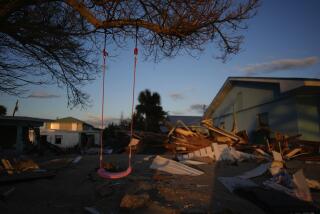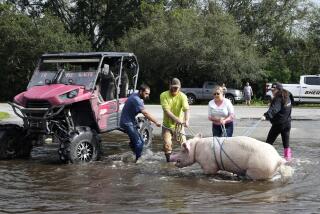Ivan Hits Alabama, Cutting Wide Swath Through Region
MOBILE, Ala. — Hurricane Ivan made landfall with staggering force early this morning, lashing southern Alabama with 135 mph winds and threatening much of the Gulf Coast with surging floodwaters.
The storm’s eye passed just east of this historic port town, the heart of a metropolitan area that is home to more than a quarter of a million people.
Families gathered in hallways and basements as trees snapped outside, transformers exploded and debris flew through the air.
“It’s roaring here. It’s a high, screaming whistle,” said Mike Etheredge, a cook who was riding out the storm in a downtown restaurant. “It’s definitely Mother Nature unleashed. You have no control over this.”
Officials said the storm surge of as much as 16 feet, accompanied by 10 to 15 inches of rain, could submerge the city’s downtown as the storm sweeps through.
The National Hurricane Center in Miami reported Wednesday evening that a buoy south of Dauphin Island, Ala., a narrow barrier island, had recorded a 45-foot swell as the storm lumbered toward shore.
“It’s going to be a very frightening experience,” Paulette Williams, director of emergency services in Mobile County, said as the storm moved closer Wednesday night.
As menacing as it appeared, the storm’s track made the worst-case scenario -- a full-bore strike on New Orleans -- unlikely.
“There will be damage. But a direct hit would be a catastrophe,” said Louisiana National Guard Lt. Col. Pete Schneider.
Government agencies were scrambling to prepare. President Bush said Wednesday that he had spoken to gulf state governors to pledge federal aid for recovery. The U.S. Coast Guard closed eight ports, including the ports of New Orleans and Mobile.
Federal officials cautioned that to a large degree, it didn’t matter what precise track the storm took in its final hours before landfall. Hurricane-force winds extended 105 miles in every direction from Ivan’s eye, with tropical-storm-force winds stretching nearly 100 miles beyond that. Four states lining the Gulf of Mexico -- Louisiana, Mississippi, Alabama and Florida -- were being affected by the relentless wind and powerful waves.
Ivan, which killed 68 people as it tore through the Caribbean in recent days, carried sustained winds of 135 mph as it came ashore. At 1 a.m. CDT the storm was moving north across the coast at about 12 mph.
Damage from the storm is not expected to be limited to coastal areas; hurricane center scientists said Ivan could bring 20 inches of rain and widespread flooding to parts of the Southeast in coming days, particularly in the Appalachians, where it threatened to stall, hemmed in by other weather systems.
“Prepare for the worst,” meteorologist Hector Guerrero said. “Hope for the best. But prepare for the worst.”
Wednesday evening, long before the heart of the storm arrived, two people were reported killed by tornadoes in Panama City, Fla., a beachfront community in the Panhandle. Other victims were believed trapped in destroyed buildings, although officials were still sifting through the wreckage.
More than 300,000 people had evacuated 13 Panhandle counties by Wednesday night, said Frank Penela, a spokesman for the Florida Emergency Operations Center in Tallahassee.
Power outages occurred as Ivan’s core approached shore, and several houses were reported destroyed in beach towns as exhausted and exasperated emergency officials braced for yet another storm. Florida has been struck by a tropical storm and two major hurricanes in a little more than a month before Ivan.
“It’s one of the hazards of living in paradise,” Penela said. “But we are a resilient state.”
On the western edge of the storm, those still in New Orleans were breathing a little more easily late Wednesday.
The city is 6 feet below sea level and ill-equipped to handle a major storm. Emergency officials had said that in the event of a direct hit, flooding could overwhelm the complex system of levees and pumps serving the city. Some predicted that 50,000 people in a metropolitan area of 1.2 million could have drowned in 20 feet of water, sewage and chemical spills from industrial plants.
“You’d essentially have a big bowl of water with nowhere to go,” Schneider said.
Ivan’s slight turn away from New Orleans was of particular relief because a massive evacuation there had threatened to dissolve into chaos in recent days -- with miles upon miles of gridlock, no hotel rooms and no rental cars left.
The city had opened just one public shelter, at the Louisiana Superdome. But refuge inside the 72,000-seat stadium was reserved for the frail, the elderly, the disabled and families with children.
Many of the city’s poorer residents had no haven to turn to and no cars to escape in; city officials advised them to try “vertical evacuation” -- going to the upper floors of buildings or into attics.
Thousands of tourists and other visitors also were left behind. Gina Ripley, a 47-year-old safety manager from Maine, had arrived in New Orleans on Sunday for a National Safety Council convention. She and several colleagues attempted to evacuate but, unlike the hundreds of thousands who did make it out in recent days, were stranded.
“There were no flights and no rental cars,” she said. “There was nothing left to do but stay here and hunker down.”
After buying some snacks to last her a couple of days and filling her hotel room bathtub with water as a precaution, Ripley attempted to weather the storm the New Orleans way: with a drink in hand. She juggled four frozen daiquiris, two for her, two for a friend back at their hotel.
“You’ve got to get them while you can,” she said. “A hurricane’s coming, but you might as well enjoy yourself and make the best of it.”
Others planned to leave, but then heard horror stories from acquaintances who had left before them, including tales of 20-hour car trips between New Orleans and Baton Rouge -- typically a two-hour trip.
“I’d rather be in my home than on the interstate when the storm hits,” said David Morris, 46, an artist who lives in the French Quarter.
Morris had planned to leave until a friend called to report that he had spent seven hours in traffic just trying to get out of New Orleans. The friend turned around in frustration and went home.
“I think we’ll be fine,” he said. “We won’t be getting the brunt of the storm.”
At 10:30 p.m. Wednesday, some of the visitors stuck in New Orleans were wondering what all the fuss was about.
“It’s a pleasant, gentle night,” said Pat Rau of Dayton, Ohio, who was stranded while attending a conference and was relaxing at a hotel. “Where’s the storm? You step out the door, and it’s not here.”
In Mobile, residents appeared more shaken by Ivan. Even some of those who declined to leave were being forced out -- in one case, a woman flew into town to rescue her mother.
Yvonne Caruso, 56, was so alarmed by her mother’s nonchalance about the storm that she flew to Mobile from Ketchikan, Alaska, a 24-hour, four-leg journey. By the time she arrived, water already was seeping into the 78-year-old woman’s backyard. The woman, who had avoided tracking the hurricane in the media because it was too upsetting, agreed to climb in the car with Caruso and drive north.
“The minute that plane touched down in Mobile, I knew everything was all right,” Caruso said. “I thought, if anything, I can hitchhike to the house if I had to. I knew I was within striking distance. It was a big relief.”
Mobile’s stately and timeworn downtown, lined with handsome wrought-iron balconies and bars for merchant seamen, was empty Wednesday except for workmen nailing boards over windows. At least 95,800 Alabama households were without power at 11:30 p.m. Wednesday, according to a spokesperson for Alabama Power Co., though the core of the storm did not arrive for several more hours. A scattered few were left in the area; six of them were at Loretta’s, a downtown restaurant.
Etheredge, 52, the head cook there, was providing meals of chili dogs and biscuits.
Etheredge was not relaxed -- far from it. The group would soon face the danger of flooding that was expected to submerge the first story of downtown buildings, forcing them to climb to the second floor of the restaurant. Looking out at the street, he remembered odd sights from past hurricanes, such as dead birds that fell to the ground after being killed and then carried inland by powerful wind.
“You’re going to have garbage cans, Dumpsters, wooden panels off fences, he said. “It’s going to bring in things it’s had inside of it since it hit Cuba. I’m not sure if this is the best place for us to be. I’m worried -- I am.”
In the hours before the last law enforcement officers left Dauphin Island on Wednesday, they visited a handful of residents who had declined to follow evacuation orders. Forty people were asked to provide telephone numbers to contact their next of kin; a chaplain was provided to talk to the law enforcement officers about the encounters.
“It’s not an easy job,” said Monroe County, Ala., sheriff’s spokeswoman Christina Bowersox. “At a certain point, if people present themselves in a determined way, you have to accept their point of view.”
Most of the 40 eventually changed their minds. By Wednesday night, as the wind rose to about 50 mph and water began creeping across the western end of the island, seven remained. Authorities feared for their lives; Mobile County Commissioner Stephen Nodine said waves there already were larger than those that accompanied Hurricane Frederic, which blew through the Mobile region in 1979 and was the worst natural disaster in Alabama history.
“See that island there?” he asked of Dauphin. “That is not going to be there.”
NASA officials, whose compound at Cape Canaveral, Fla., took a beating from Hurricane Frances this month, were doing what they could to protect their Gulf Coast facilities.
At the John C. Stennis Space Center, on the southern tip of Mississippi, a team of essential personnel prepared to ride out the storm after securing two flight-ready space shuttle engines. Stennis is NASA’s primary center for testing rocket propulsion systems, including the main shuttle engines.
This year’s hurricane season has been an exhausting ordeal for millions of residents in the Southeast. But the season is not over -- not by a long shot.
On Wednesday, Tropical Storm Jeanne began lashing Puerto Rico with winds of more than 70 mph. The storm could reach Florida by the weekend.
*
Barry reported from Mobile, Hart from New Orleans and Gold from Houston. Times staff writer Maura Reynolds in Washington contributed to this report.
More to Read
Sign up for Essential California
The most important California stories and recommendations in your inbox every morning.
You may occasionally receive promotional content from the Los Angeles Times.











